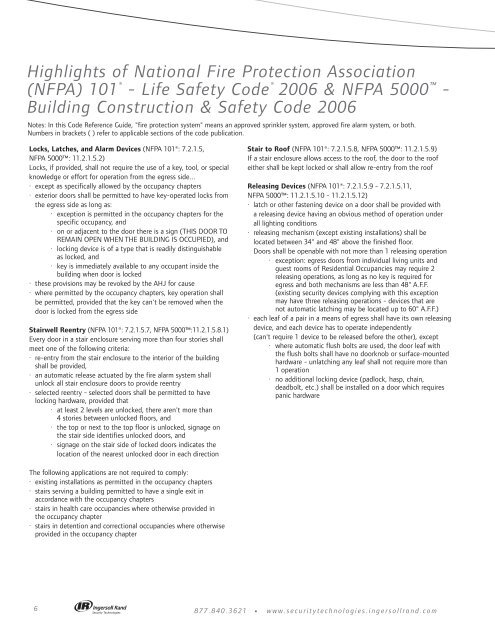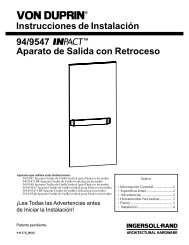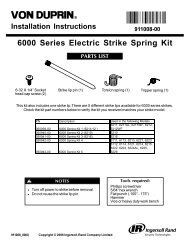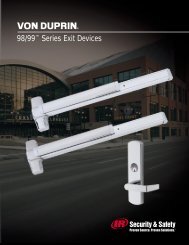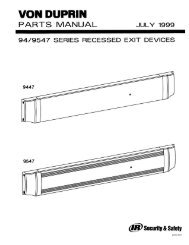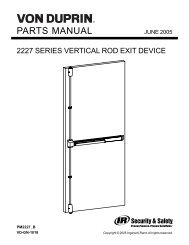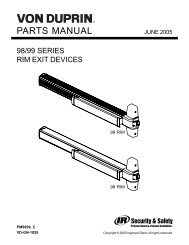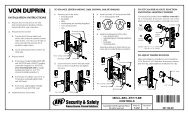Fire, Life Safety & Accessibility Codes - Von Duprin
Fire, Life Safety & Accessibility Codes - Von Duprin
Fire, Life Safety & Accessibility Codes - Von Duprin
Create successful ePaper yourself
Turn your PDF publications into a flip-book with our unique Google optimized e-Paper software.
Highlights of National <strong>Fire</strong> Protection Association<br />
(NFPA) 101 ® - <strong>Life</strong> <strong>Safety</strong> Code ® 2006 & NFPA 5000 -<br />
Building Construction & <strong>Safety</strong> Code 2006<br />
Notes: In this Code Reference Guide, "fire protection system" means an approved sprinkler system, approved fire alarm system, or both.<br />
Numbersinbrackets()refertoapplicable sections of the code publication.<br />
Locks, Latches, and Alarm Devices (NFPA 101®: 7.2.1.5,<br />
NFPA 5000: 11.2.1.5.2)<br />
Locks, if provided, shall not require the use of a key, tool, or special<br />
knowledge or effort for operation from the egress side...<br />
· except as specifically allowed by the occupancy chapters<br />
· exterior doors shall be permitted to have key-operated locks from<br />
the egress side as long as:<br />
· exception is permitted in the occupancy chapters for the<br />
specific occupancy, and<br />
· on or adjacent to the door there is a sign (THIS DOOR TO<br />
REMAIN OPEN WHEN THE BUILDING IS OCCUPIED), and<br />
· locking device is of a type that is readily distinguishable<br />
as locked, and<br />
· key is immediately available to any occupant inside the<br />
buildingwhendoorislocked<br />
· these provisions may be revoked by the AHJ for cause<br />
· where permitted by the occupancy chapters, key operation shall<br />
be permitted, provided that the key can't be removed when the<br />
door is locked from the egress side<br />
Stairwell Reentry (NFPA 101®: 7.2.1.5.7, NFPA 5000:11.2.1.5.8.1)<br />
Every door in a stair enclosure serving more than four stories shall<br />
meet one of the following criteria:<br />
· re-entry from the stair enclosure to the interior of the building<br />
shall be provided,<br />
· an automatic release actuated by the fire alarm system shall<br />
unlock all stair enclosure doors to provide reentry<br />
· selected reentry - selected doors shall be permitted to have<br />
locking hardware, provided that<br />
· at least 2 levels are unlocked, there aren't more than<br />
4 stories between unlocked floors, and<br />
· the top or next to the top floor is unlocked, signage on<br />
the stair side identifies unlocked doors, and<br />
· signage on the stair side of locked doors indicates the<br />
location of the nearest unlocked door in each direction<br />
The following applications are not required to comply:<br />
· existing installations as permitted in the occupancy chapters<br />
· stairs serving a building permitted to have a single exit in<br />
accordance with the occupancy chapters<br />
· stairs in health care occupancies where otherwise provided in<br />
the occupancy chapter<br />
· stairs in detention and correctional occupancies where otherwise<br />
provided in the occupancy chapter<br />
Stair to Roof (NFPA 101®: 7.2.1.5.8, NFPA 5000: 11.2.1.5.9)<br />
If a stair enclosure allows access to the roof, the door to the roof<br />
either shall be kept locked or shall allow re-entry from the roof<br />
Releasing Devices (NFPA 101®: 7.2.1.5.9 - 7.2.1.5.11,<br />
NFPA 5000: 11.2.1.5.10 - 11.2.1.5.12)<br />
· latch or other fastening device on a door shall be provided with<br />
a releasing device having an obvious method of operation under<br />
all lighting conditions<br />
· releasing mechanism (except existing installations) shall be<br />
located between 34" and 48" above the finished floor.<br />
Doors shall be openable with not more than 1 releasing operation<br />
· exception: egress doors from individual living units and<br />
guest rooms of Residential Occupancies may require 2<br />
releasing operations, as long as no key is required for<br />
egress and both mechanisms are less than 48" A.F.F.<br />
(existing security devices complying with this exception<br />
may have three releasing operations - devices that are<br />
not automatic latching may be located up to 60" A.F.F.)<br />
· each leaf of a pair in a means of egress shall have its own releasing<br />
device, and each device has to operate independently<br />
(can't require 1 device to be released before the other), except<br />
· where automatic flush bolts are used, the door leaf with<br />
the flush bolts shall have no doorknob or surface-mounted<br />
hardware - unlatching any leaf shall not require more than<br />
1operation<br />
· no additional locking device (padlock, hasp, chain,<br />
deadbolt, etc.) shall be installed on a door which requires<br />
panic hardware<br />
6 877.840.3621 • www.securitytechnologies.ingersollrand.com


